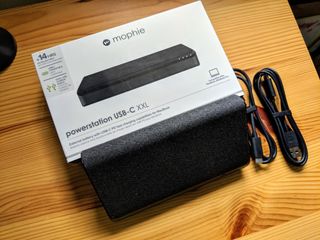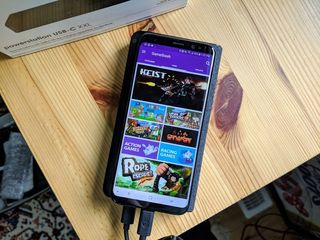Can Mophie make an argument for the $150 battery pack?

Search "[battery pack](https://www.amazon.com/s/ref=nb_sb_noss_1?url=search-alias%3Daps&field-keywords=battery+pack&tag=androidcentralb-20&ascsubtag=UUacUdUnU63625" on Amazon and there's no shortage of high-quality options at reasonable prices. Once-unknown brands like Aukey, Anker, and RAVPower seem to have maneuvered their way to the tops of the search results, and hundreds of thousands of happy customers regale the user reviews sections with tales of successful deals on top-notch componentry.

When a battery pack that can charge a phone, a tablet, and a laptop at the same time costs a hair under $40, can Mophie convince people that it's worth spending nearly four times that amount on a portable charger that has less capacity and fewer ports? That's what we're aiming to answer here.

This is definitely the nicest-looking battery pack I've used, but that doesn't mean much in the long run.
The Mophie Powerstation USB-C XXL is a two-port charger with a USB-C port and a USB-A port splitting the responsibilities. Its 19500mAh capacity is, while capacious — especially for its relatively small size — not the biggest we've seen, but the Mophie is programmed to release that capacity as quickly as possible right now.
That's because, in addition to the USB-A port that supports standard 2.4 amp output, the USB-C port uses the Power Delivery standard, allowing for up to 30W of output with a compatible device and proper cable. As we learned from the Pixel 2, most phones don't support such wattage — it technically supports a 27W charger, but will only accept 18 watts, likely due to heat concerns. Still, the Mophie can charge a phone and tablet at the same time, or a phone and USB C-capable laptop (say, a Pixelbook), which is pretty great.
For most products on the market today, the USB-C port will output 3A, which is roughly equivalent to Quick Charge 3.0 speeds.

The battery itself is hefty and solid, wrapped in a fabric outer layer that, after a few weeks tossed into the bottom of my bag, has worn incredibly well. The single button uses four white LED buttons to indicate battery levels, and unlike many other chargers, the Powerstation is intelligent enough not to need an "on" button to start charging something that's plugged in.
Be an expert in 5 minutes
Get the latest news from Android Central, your trusted companion in the world of Android
So why spend $150 on a battery when larger capacities are available at a third of the cost? Well, USB-PD is a burgeoning standard not supported by most battery chargers yet, and its licensing fees are reportedly higher than Quick Charge and other fast charging standards. Mophie is also well known for its high-quality components, and the Powerstation's two-year warranty should be reassuring for those willing to take the plunge.
I can say that the Powerstation USB-C XXL is not three times better than the average battery pack from RAVPower, Anker, Aukey, and others, but in my time with it, it's been incredibly reliable, useful, and hardy.
Daniel Bader was a former Android Central Editor-in-Chief and Executive Editor for iMore and Windows Central.

